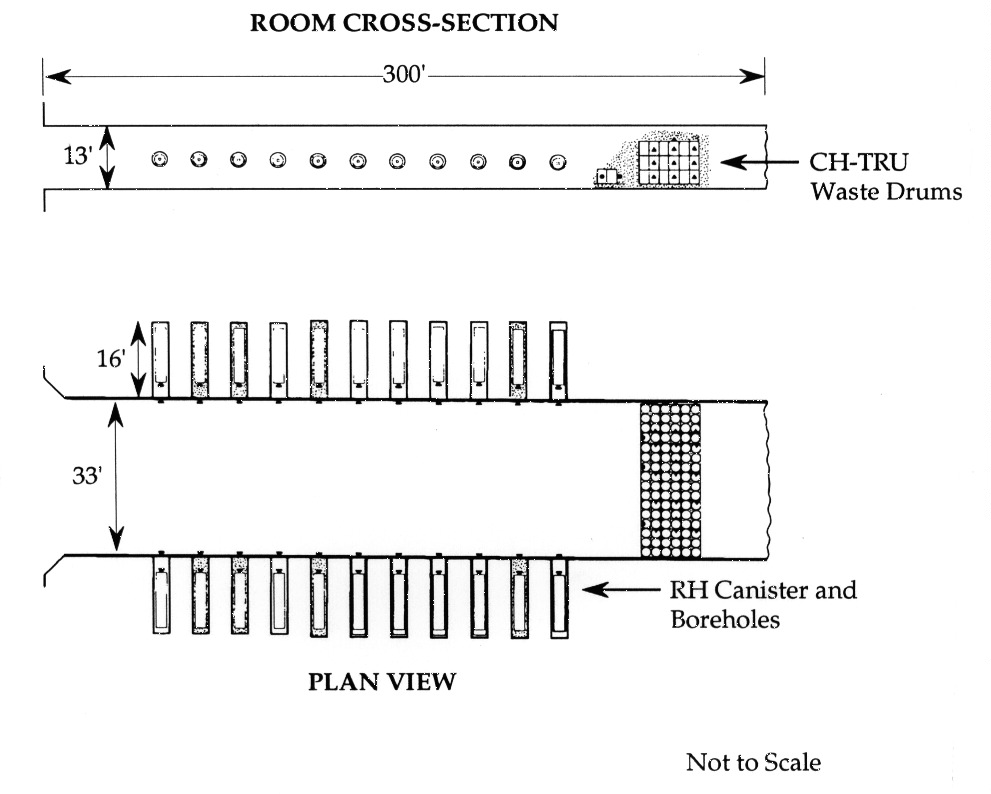2.0 THE TRANSURANIC WASTE DISPOSAL STRATEGY
The strategy for disposal of defense-related TRU waste includes implementation of the necessary regulatory and programmatic activities to ensure disposal of the maximum allowable inventory, consistent with statutory and other legal limitations, that can be demonstrated to be acceptable in compliance evaluations. Several fundamental elements of the RH-TRU program are currently in the development stages. The Waste Isolation Pilot Plant Remote-Handled Transuranic Waste Disposal Strategy document [DOE, 1995d] addresses these elements and the programs that are supporting development. The Remote-Handled Transuranic Waste Study addresses only those aspects of RH-TRU wastes that pertain to the requirements defined in the LWA. The transportation elements of this program can be found in the Comparative Study of Waste Isolation Pilot Plant (WIPP) Transportation Alternatives [DOE, 1994].
RH-TRU disposal elements that are pertinent to this study include room configuration, waste packaging, shield plugs, and the physical and radiological characteristics of the RH-TRU waste inventory. The following subsections discuss the current strategy for CH-TRU and RH-TRU waste disposal.
2.1 Room Configuration
The waste disposal area within WIPP consists of eight panels, each containing seven rooms between access drifts. The RH-TRU wastes will be emplaced in a manner different from that for the CH-TRU wastes because of packaging, shielding, and loading requirements; operational equipment; and structural considerations. The current disposal configuration of the CH-TRU inventory includes emplacement of the waste packages in disposal rooms that measure 33 ft wide, 13 ft high, and 300 ft long [Sandia WIPP Project, 1992] (see Figure 2-1). The current configuration for RH-TRU disposal includes emplacement into the walls in horizontal boreholes. These boreholes will be drilled 4 feet from the floor on 8-foot centers [Sandia WIPP Project, 1992]. There will be a total of approximately 7,955 RH-TRU waste boreholes.
Figure 2-1
A shield plug capping each borehole after emplacement of the RH-TRU canister in the room wall will provide the necessary shielding required for worker safety. This shield plug is constructed of carbon steel and weighs approximately 4,200 pounds. Appendix A includes a description of the RH-TRU shield plug currently planned for implementation. The CH-TRU waste inventory will be emplaced in the disposal rooms following completion of all RH-TRU waste disposal activities in that room.
2.2 Waste Packaging
CH-TRU waste containers will be transported and received in a U.S. Nuclear Regulatory Commission (NRC)-certified TRUPACT-II shipping container. The CH-TRU waste packaging will include 55-gallon drums, Standard Waste Boxes (SWBs), and Ten Drum Overpacks (TDOs) [Nuclear Packaging, Inc., 1992]. The SWB is an oblong steel box that is 37 in. high, 54.25 in. wide, and 71 in. long. The TDO is a welded-steel right circular cylinder 74 in. in diameter and 74 in. high.
RH-TRU wastes will be received at WIPP in NRC-certified type B shipping containers. One canister, which holds approximately three 55-gallon drum equivalents of waste, will be emplaced into each borehole. Each RH-TRU canister is made of 0.25-inch-thick carbon steel, is 121 in. long and 26 in. in diameter. Appendix A includes a description of the RH-TRU canister to be used for disposal. The waste container requirements for WIPP are described in the WIPP Waste Acceptance Criteria (WAC) [DOE, 1991].
2.3 TRU Waste Inventory
The [1]Waste Isolation Pilot Plant Transuranic Waste Baseline Inventory Report (WTWBIR) [DOE, 1995e] data gives inventory quantities and waste material parameters for TRU waste. These data, as well as the radionuclide inventory, are supplied by the DOE waste generator/storage sites. Summaries of the radionuclide and non-radionuclide inventories were obtained from the WTWBIR and will be used in the PA process.
The radionuclide inventories of both CH-TRU and RH-TRU wastes are determined using (1) nondestructive assay, (2) some destructive analyses (to detect isotopes that do not lend themselves to nondestructive analyses or to evaluate waste streams that cannot be effectively analyzed through nondestructive methods), and (3) on-site accountability and tracking records of special nuclear materials, which record any changes of isotopic ratios during processing [DOE, 1995e].
The WTWBIR provides descriptions for the waste material parameters in TRU waste. The waste material parameters that have been identified by PA as being potentially significant to WIPP performance are as follows:
- Iron-base metal/alloys, aluminum-base metal/alloys, other metals, and other inorganics.
- Cellulose, rubber, and plastic.
- Solidified inorganic and organic waste.
- Soils.
- Container Materials: Steel, plastic liners, lead, and steel plug.
Footnote
[1] The Waste Isolation Pilot Plant Transuranic Waste Baseline Inventory Report (WTWBIR) [DOE, 1995e] is available to interested readers by sending a request to:
U.S. Department of Energy
Carlsbad Field Office
4021 National Parks Highway
Carlsbad, New Mexico 88220
Continue to Section 3
Return to Table of Contents
|
Notice To Users: |
Have a question about WIPP? |